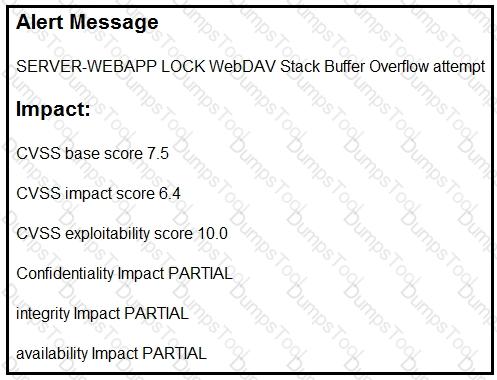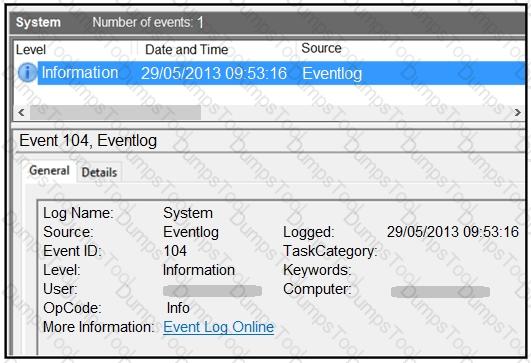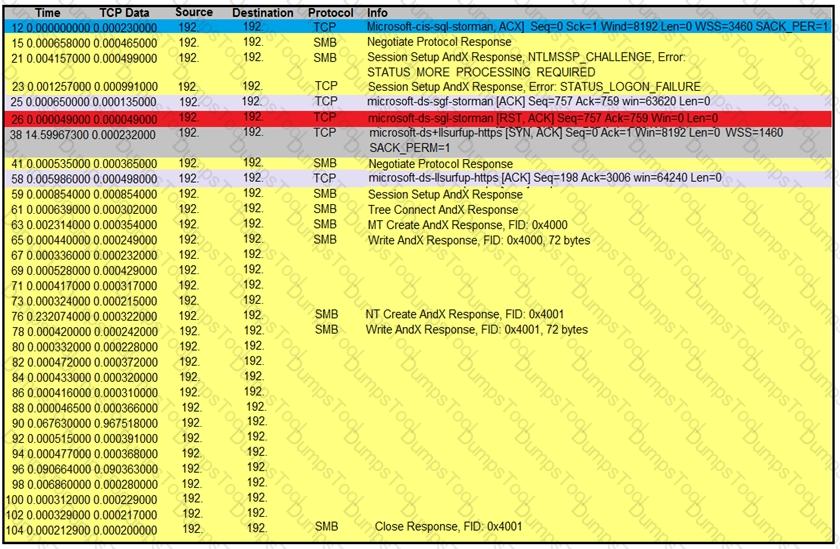An incident response analyst is preparing to scan memory using a YARA rule. How is this task completed?
Snort detects traffic that is targeting vulnerabilities in files that belong to software in the Microsoft Office suite. On a SIEM tool, the SOC analyst sees an alert from Cisco FMC. Cisco FMC is implemented with Snort IDs. Which alert message is shown?
An employee receives an email from a “trusted” person containing a hyperlink that is malvertising. The employee clicks the link and the malware downloads. An information analyst observes an alert at the SIEM and engages the cybersecurity team to conduct an analysis of this incident in accordance with the incident response plan. Which event detail should be included in this root cause analysis?
An engineer is analyzing a ticket for an unexpected server shutdown and discovers that the web-server ran out of useable memory and crashed.
Which data is needed for further investigation?
A website administrator has an output of an FTP session that runs nightly to download and unzip files to a local staging server. The download includes thousands of files, and the manual process used to find how many files failed to download is time-consuming. The administrator is working on a PowerShell script that will parse a log file and summarize how many files were successfully downloaded versus ones that failed. Which script will read the contents of the file one line at a time and return a collection of objects?
An organization experienced a ransomware attack that resulted in the successful infection of their workstations within their network. As part of the incident response process, the organization's cybersecurity team must prepare a comprehensive root cause analysis report. This report aims to identify the primary factor or factors responsible for the successful ransomware attack and to formulate effective strategies to prevent similar incidents in the future. In this context, what should the cybersecurity engineer emphasize in the root cause analysis report to demonstrate the underlying cause of the incident?
Refer to the exhibit.

According to the Wireshark output, what are two indicators of compromise for detecting an Emotet malware download? (Choose two.)
Refer to the exhibit.

After a cyber attack, an engineer is analyzing an alert that was missed on the intrusion detection system. The attack exploited a vulnerability in a business-critical, web-based application and violated its availability. Which two mitigation techniques should the engineer recommend? (Choose two.)
A new zero-day vulnerability is discovered in the web application. Vulnerability does not require physical access and can be exploited remotely. Attackers are exploiting the new vulnerability by submitting a form with malicious content that grants them access to the server. After exploitation, attackers delete the log files to hide traces. Which two actions should the security engineer take next? (Choose two.)
A malware outbreak revealed that a firewall was misconfigured, allowing external access to the SharePoint server. What should the security team do next?
A security team received reports of users receiving emails linked to external or unknown URLs that are non-returnable and non-deliverable. The ISP also reported a 500% increase in the amount of ingress and egress email traffic received. After detecting the problem, the security team moves to the recovery phase in their incident response plan. Which two actions should be taken in the recovery phase of this incident? (Choose two.)
An engineer received a call to assist with an ongoing DDoS attack. The Apache server is being targeted, and availability is compromised. Which step should be taken to identify the origin of the threat?
An incident response team is recommending changes after analyzing a recent compromise in which:
a large number of events and logs were involved;
team members were not able to identify the anomalous behavior and escalate it in a timely manner;
several network systems were affected as a result of the latency in detection;
security engineers were able to mitigate the threat and bring systems back to a stable state; and
the issue reoccurred shortly after and systems became unstable again because the correct information was not gathered during the initial identification phase.
Which two recommendations should be made for improving the incident response process? (Choose two.)
Refer to the exhibit.

An employee notices unexpected changes and setting modifications on their workstation and creates an incident ticket. A support specialist checks processes and services but does not identify anything suspicious. The ticket was escalated to an analyst who reviewed this event log and also discovered that the workstation had multiple large data dumps on network shares. What should be determined from this information?
Refer to the exhibit.

A cybersecurity analyst is presented with the snippet of code used by the threat actor and left behind during the latest incident and is asked to determine its type based on its structure and functionality. What is the type of code being examined?
During a routine inspection of system logs, a security analyst notices an entry where Microsoft Word initiated a PowerShell command with encoded arguments. Given that the user's role does not involve scripting or advanced document processing, which action should the analyst take to analyze this output for potential indicators of compromise?
An engineer must advise on how YARA rules can enhance detection capabilities. What can YARA rules be used to identify?
An analyst finds .xyz files of unknown origin that are large and undetected by antivirus. What action should be taken next?
An engineer is analyzing a DoS attack and notices that the perpetrator used a different IP address to hide their system IP address and avoid detection. Which anti-forensics technique did the perpetrator use?
Refer to the exhibit.

An engineer is analyzing a TCP stream in Wireshark after a suspicious email with a URL. What should be determined about the SMB traffic from this stream?
A network host is infected with malware by an attacker who uses the host to make calls for files and shuttle traffic to bots. This attack went undetected and resulted in a significant loss. The organization wants to ensure this does not happen in the future and needs a security solution that will generate alerts when command and control communication from an infected device is detected. Which network security solution should be recommended?
A security team detected an above-average amount of inbound tcp/135 connection attempts from unidentified senders. The security team is responding based on their incident response playbook. Which two elements are part of the eradication phase for this incident? (Choose two.)